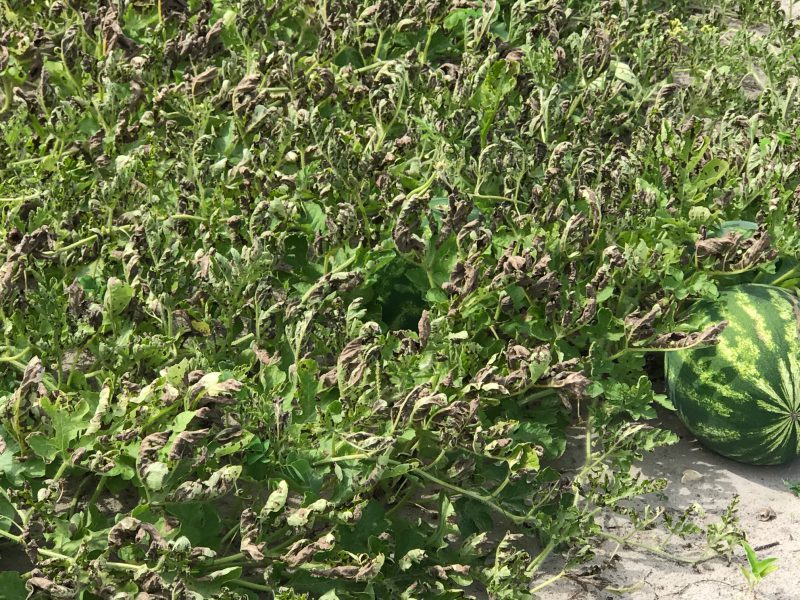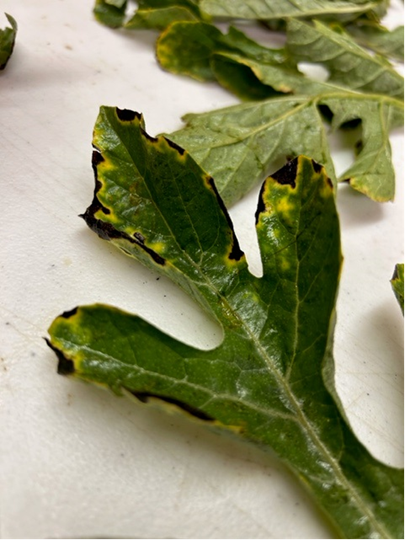Bob Hochmuth, Regional Specialized Extension Agent- Vegetable Crops – Published April 30, 2023
Welcome to the 2023 growing season, weekly issue of the UF/IFAS Extension Suwannee Valley Watermelon Crop Update. These updates are summarized by Bob Hochmuth, Regional Specialized Extension Agent- Vegetable Crops, with input from Suwannee Valley Extension Agents: Mark Warren (Levy), Tyler Pittman (Gilchrist), Tatiana Sanchez (Alachua), Luke Harlow (Bradford), Jay Capasso (Columbia), Dan Fenneman (Madison), Keith Wynn (Hamilton), Emily Beach (Lafayette), Jim Devalerio (Union), De’Anthony Price (Jefferson), Bob Hochmuth (for vacant Suwannee position), Kevin Athearn (RSA-Agri- business), and Sudeep Sidhu (RSA- Water Resources). If you know someone who wants to be added to this weekly notice, contact your Extension Agent or Mark Warren (352-949-8288) if you want to be added to the regional watermelon group text app.
We have initiated a more formal way to support our watermelon growers with a rapid diagnostics system through Suwannee Valley Regional and County Extension Agents. This industry-funded program allows Extension Agents to submit and pay for watermelon grower’s plant disease and other diagnostic samples. This SV Rapid Diagnostic Watermelon Program will help us to get quicker diagnostic results, helping to give early alerts to everyone, and not have to charge the growers directly. Sponsors of this program in 2023 to date include Harrell’s, TriEst Ag, Gowan USA, and Syngenta Crop Protection. Company representatives interested in sponsoring can contact Bob Hochmuth at bobhoch@ufl.edu or 386-288-6301.
Reminder: Get everything together for your food safety program. Have all your records in order before things get hectic at harvest.
–
Disease Updates
–
First Case of Downy Mildew Confirmed
Well, we hoped we may escape this season without seeing downy mildew. But, we now have our first confirmed case of the 2023 season for downy mildew in the Suwannee Valley region, in Levy County. The confirmation comes from our UF Plant Disease Lab on campus. See pages 40-41 in your UF/IFAS Watermelon Field Guide.
–
Before I go any further, I want to caution everyone that these alerts do not necessarily mean everyone should automatically pull the trigger on control measures. In fact, this has always been a concern of mine with these weekly updates. We do want everyone to have a heightened alert and to intensify scouting when we indicate alerts for any of these diseases or other pests. But our intent is to make sure everyone knows what is happening in the region, so you can make the best decision possible on your own farm.
Downy mildew is the disease traditionally known as “wildfire” and arrived last year about this same time, but a little later in May in 2022. Because of the high risk of damage and movement throughout the region, we are expressing a high level of concern. We encourage you to consider a spray plan, if you have not already initiated one, targeted at downy mildew, especially in the southern parts of the Suwannee Valley region (Levy and Gilchrist County is where the report has been made. However, it is expected to continue to move north to Suwannee, Lafayette, Columbia, Madison, and Union Counties next. Contact your Extension Agent if you see areas of the field where the plants look blighted (dried up leaves sticking straight up in the mid part of the canopy). The leaves in more advanced stages will quickly become “crispy” with the leaf veins being the only part of the leaf not to become crispy and dry (see Photos below). You should consider adding one of these fungicides to your program soon. The best choices, based on recent trials, are Ranman, Orondis Ultra, or Zampro (all three have a zero-day pre-harvest interval (PHI)) and should be added to a broader spectrum mancozeb (Manzate or Penncozeb (5-day PHI)) spray plus either Quintec or Procure, for the continued management of powdery mildew. Good luck with this additional challenge. For those fields where downy mildew has been confirmed, we have suggested starting with Orondis Ultra or Zampro this week and Ranman next week. Where downy mildew has not yet been detected, you could start with Ranman this week and follow with Orondis Ultra, or Zampro. (Hochmuth)
–
Watermelon Mosaic Virus
We have begun seeing a few patches of watermelon mosaic virus, transmitted by aphids earlier in the season (See Photo A right and pages 44-45 in the UF/IFAS Watermelon Field Guide). There is no need to worry about this virus now, mainly because we have no cure. It usually only impacts the crop in a minor way until later in the season. (B.Hochmuth).
–
Copper Toxicity Issues
We have seen symptoms of copper toxicity in fields where copper was sprayed repeatedly for bacterial spot with no rainfall to “wash it off.” Copper toxicity shows as a bright yellow margin on the leaves and later can turn brown on that margin. See pages 20-21 in the UF/IFAS Watermelon Field Guide and the Photo B below. (B. Hochmuth)
- 2024 Watermelon Season Wrap Up - June 21, 2024
- Weekly Watermelon Update – June 3 - June 7, 2024
- Weekly Watermelon Update #10 – May 20 - May 24, 2024



